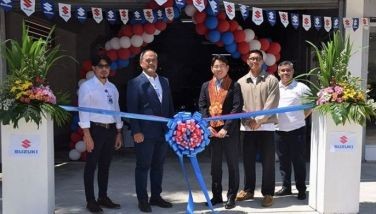Déjà vu in motoring?
When our motoring section editor, ladies’ man Manny delos Reyes made mention that this week’s section theme would be something like a look back at the year that was in Philippine motoring, I simply dug into our archives of this year’s Motoring Today columns and our weekly TV show’s motoring news scripts.
And going through them, I couldn’t help reviewing the past years’ columns and scripts as well. No, I didn’t go as far as 27 years back when we started the longest-running motoring show on Philippine television. I didn’t have to. Because even reviewing news and developments of just a few years back, it feels like we’ve been here before, we’ve done this before, we’ve said this before, and we’ve said ‘deja vu’ before, about the same problems, the worsening traffic, the preventable accidents that were not prevented, bad roads, bad road engineering, the not-so-brilliant solutions and regulations to such problems, the same mistakes made and committed albeit with different names, acronyms, catch-phrases.
But to be fair to those in government and in the private sector who made our daily motoring experience happier, there were moments that stood as game changers for the better and of course we can’t say enough about how social media, mobile communication technology and apps have affected our lives, including our motoring experience on Twitter, Facebook, YouTube, many can’t get away with being bad on the road and being good gets instant recognition.
Well, limited space forces us to make personal judgment as to what we feel were the highlights of the year that was in motoring.
First Quarter
Right at the start of 2014 we again discover another heretofore unheard of government regulation causing delays in one vital project—deja vu? You bet it is! This time it’s the P3.8-billion Land Transportation Plate Standardization Project. After months of delays, the bidding process is over, but the winning bidder can’t get his contract because the DOTC and the Department of Budget and Management can’t get their act together over a minor issue called multi-year obligational authority. What dat? Only the bureaucrats know.
It had to take an accident of tragic proportions—the death of 15 after a bus fell off a ravine in the Mt. Province including popular artist and comedian Tado, to reveal what many of us are already aware of, that many buses from major urban centers to outlying areas, are being operated without franchises or authority to operate and Frankenstein buses, sporting a dubious mix of chassis and engine numbers, license plates and authorities to operate. The LTFRB suddenly is taking strict action against such operators. GV Florida is the first to bear the brunt of this belated strictness in applying transport laws against erring operators, 228 of their buses covering 32 different franchises are suspended pending resolution of the case against the operator.
The Mt. Province accident comes in the wake of other accidents involving buses and trucks and prompts lawmakers to join the clamor for speed limiters on buses and trucks and other public utility vehicles. This is both a deja vu and possible game changer moment. Deja vu, because many lawmakers just love to clamber into popular bandwagons and game changer, because many say that speed limiters, as proven in other countries, really do bring down the number of bus and truck accidents.
The biggest game changer in this context should be the move to issue a joint LTO-LTFRB administrative order that will radically increase the fines for colorum or unauthorized operation of public transport services, including up to P1million for colorum buses. Radical because the fine up till then was just P6,000 . .
Riding-in-tandem crime has been on the rise. The PNP seeking carte blanche from the LTO to go after motorcycle riders without license plates and proposed ordinances to require riders to wear vests with the alphanumeric of their ride’s license plates. But of course—deja vu—riders and riders’ associations, many active in on-line forums and social media oppose any and all restrictions to their enjoyment of their two-wheel ride.
Among the biggest game changers in the first quarter of the year was the decision of the Manila City government to restrict the entry of buses in the city. It helped ease traffic congestion in the city, yes, but we will find out soon enough and later in the year, there was a good and bad side to this move.
Second Quarter
Onto the second quarter of 2014, another bus company, Southern Carrier Company Inc. is involved in a serious accident on the SLEX, fortunately nothing fatal and when LTFRB investigated the incident, it found the bus company operating with an expired franchise. The company loophole in LTFRB regulations that say the company can continue operating if it has a pending application for extension of franchise and bus companies can continue doing this legally for years until the application is resolved, and why weren’t people surprised?
The upshot was that the LTFRB said that it would close that loophole and require companies to file applications for franchise extension at least six months before their expiry with LTFRB resolving this within the period—one game changer if implemented well into the next administration.
Can anyone be a bigger game-changer than US President Barak Obama? Well in his two-day State Visit to the country, the US President took time out to plug the COMET E-jeepney, a 16-seater electric vehicle that its proponents, including its US backers, say is a feasible replacement for diesel-guzzling jeepneys.
Another game-changing moment may be the coming into force in June of the Republic Act 10586, the Anti-Drunk and Drugged Driving Act of 2013, with the implementing rules and regulations already approved and ready for, yes, implementation. But wait, are the law enforcement agencies ready with the alcohol breath analyzers needed and have the enforcers been given the necessary instructions and training on the IRR of RA 10586? That’s another story that could make this game-changer into a deja vu moment. We all have experienced well-intentioned laws marred by ill-prepared implementation.
Remember the Manila City government’s game-changing policies restricting the entry of truck and semis during the first quarter of the year? By the second quarter the effects of this policy have begun to surface. Commodities are getting stuck longer in the ports and affecting trade and the economy. The national government has taken notice and begins talking with Manila Mayor Erap Estrada and Vice Mayor Isko Moreno about the complaints of truckers and shippers.
Again, the biggest game changing moment for the second quarter of 2014 was the LTO and LTFRB issuing Joint Administrative Order No. 2014-01 imposing hefty fines and graver penalties against colorum operations of buses, taxis, jeepneys and vans, even private sedans used for public transport. It also specifies heavier fines for violations of traffic regulations.
Stormy Third Quarter
Going into the third quarter of the year, the truckers are finding out that the LTFRB means business in going after colorum operations, a game-changing 2014 moment. Truckers groups are now the ones going to LTFRB and LTO to find ways to legitimize their operations. This comes at a time when Manila’s restrictions on truckers have begun affecting port operations with cargo getting stuck in the ports. In a move many see as laudable, the transport authorities agreed to give truckers time to register their truck-for-hire or cargo hauling services and truckers won’t be subject to the hefty fines in JAO 2014-01.
Meanwhile the situation at the Port of Manila has gone from bad to worse. Manila’s truck restrictions have so affected cargo and container movements that commodities are getting stuck in ports causing shortages that even affected chicken supply of a big fast-food chain. Malacanang pressured Manila Mayor Erap Estrada to ease its restrictions on trucking operators and then directed the implementation of what became known as the Last Mile solution, allowing truckers virtually free run of the metro if they are moving cargo in or out of the ports for two weeks. Truckers were happy but we all know what that did to traffic in the streets.
Meanwhile, environmentalists are hoping that the drafting of the “The Philippine Electric Vehicle Industry Growth Agenda,” a roadmap for the development of the domestic e-vehicle sector, can be a game-changing moment. The sector now boasts of 46 enterprises as manufacturers, assemblers or distributors. The road map calls for tax and other incentives for the development of the e-vehicle market in the country. The sector claims production of 38,220 units by the end of 2014 and the road map envisions the production of 69,146 units by 2017.
The third quarter sees the Metro Rail Transit 3 service going from bad to worse, and worse to worst, the worst being a train stalling between two stations. And as it was being pushed by another to the next station, it got loose and rolled past the end of the track at the EDSA-Taft station. The train broke through the steel fence before finally stopping. The incident injured 36 passengers.
Final Quarter
The final quarter of the year also the LTFRB showing that its tough policy against bus companies that get into serious accidents that injure passengers will not be a ningas cogon thing. That it will continue to penalize bus companies for serious accidents, this time it’s Victory Liner, one of few bus companies known for offering safe and efficient transport. One of its units collided with a truck at NLEX. 16 units of Victory Liner’s particular franchise that included the bus that involved in the accident were ordered suspended.
It is also serious about fining colorum bus operations one million pesos. The first to be fined is the operator of Dalin Liner after one of its buses was caught plying a route without a franchise. The LTFRB discovered that the liner’s franchise expired in 2001.
Still on colorum vehicles, the LTFRB soon woke up to the fact that there are private vehicles operating as taxis or shuttles, ferrying passengers who book them through Uber, a mobile phone application. Franchised taxi operators complained to LTFRB and an entrapment operation netted one Uber partner-driver using a Fortuner who under JAO 2014-01 would face a 200,000 peso fine for being a colorum operator. Netizens condemned the entrapment operation saying Uber and other similar transport booking apps, Grabtaxi, Tripid and Tripda were helping provide good and needed transport service. Legit taxi operators complained and called for a level playing field asking the government not to allow the use of private vehicles as taxis and to also regulate the fees they charge.
Perhaps one of the bigger game-changing moments of 2014 is the launch of a regular e-jeepney service from SM North on EDSA to Katipunan with 14 designated north and south bound loading and unloading stations. If proven profitable and patronized by commuters, may be start of a major greening of the mass transport system in Metro Manila.
This follows a growing trend of e-vehicles used for local transport at the grassroots level, the E-trikebayan in Mandaluyong and the KEA e-trikes in Bacoor where there is now a commercial charging station, the Makati Green Route in Makati using at least 20 e-jeepneys for commuters in Legaspi and Salcedo Villages.
Another game-changing initiative may be Mandaluyong City’s new ordinance that would only allow relatives—spouses, parents or siblings—to ride in tandem on motorbikes. The riders must bring proof their relationships when riding in tandem. The ordinance is intended to discourage or prevent the prevalence of riding-in-tandem crimes. If this is proven to bring down the number of such crimes in Mandaluyong, then maybe other cities can adopt the innovative ordinance.
In the last quarter of 2014, the Philippine National Railways had good reason to celebrate its 122nd founding anniversary after Congress approved a measure extending its franchise another 50 years. It also celebrated the extension of its Metro South Commuter (MSC) line, servicing passengers to and from Tutuban in Manila to Mamatid in Laguna all the way Calamba.
To date, that’s the year that was in 2014—a year of déjà vu.
Happy Motoring!!!
Comments: motoringtoday-star@stv.com.ph / sunshine.television@yahoo.com
- Latest


























